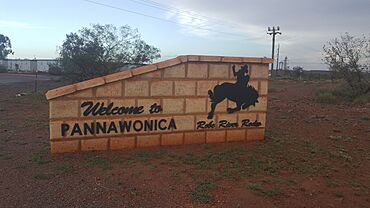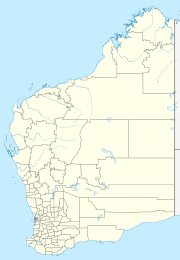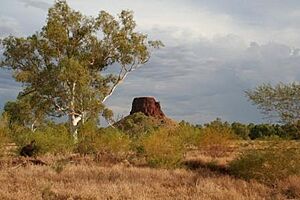Pannawonica, Western Australia facts for kids
Quick facts for kids PannawonicaWestern Australia |
|||||||||
|---|---|---|---|---|---|---|---|---|---|
 |
|||||||||
| Established | 1970 | ||||||||
| Postcode(s) | 6716 | ||||||||
| Elevation | 200 m (656 ft) | ||||||||
| Area | [convert: needs a number] | ||||||||
| Location | |||||||||
| LGA(s) | Shire of Ashburton | ||||||||
| State electorate(s) | North West Central | ||||||||
| Federal Division(s) | Durack | ||||||||
|
|||||||||
Pannawonica is a town in Western Australia where people mine for iron ore. It's in the Pilbara region, close to the Robe River. The town is about 200 kilometers (124 miles) south-west of Karratha. It is also about 1429 kilometers (888 miles) north of Perth. In 2016, about 695 people lived in Pannawonica.
Pannawonica has been known for its high incomes. In 2011 and 2016, it had one of the highest average weekly incomes in Western Australia. This was likely true for all of Australia too. This is because mine workers in the town earn good salaries.
Contents
Discovering Pannawonica's Past
Pannawonica was built in 1970 on Yalleen Station. It was created by a company called Cleveland-Cliffs Robe River Iron. This company later became Robe River Iron Associates. Eventually, it was bought by Rio Tinto Iron Ore. The town was officially recognized as a townsite in 1972.
How Pannawonica Got Its Name
The town's name comes from a nearby place called Pannawonica Hill. A surveyor named the hill in 1885. The name comes from an Aboriginal word. It means "the hill that came from the sea."
There is a traditional legend about the hill. Two local Aboriginal tribes were arguing over who owned the hill. It was located by the sea. The sea spirit decided to solve the problem. It moved the hill inland. As the hill was dragged, it left a deep mark. This mark became the Robe River.
Life in a Mining Town
Pannawonica is one of several mining towns in the Pilbara. These towns were built to house workers. These workers operate open-cut mines. They also load iron ore onto trains.
Pannawonica is known as a 'closed town'. This means it has limited services for visitors. The company's housing is mainly for its workers. It is also for contractors who visit. You can find some visitor accommodation at the Pannawonica Tavern.
More than 1000 people live in Pannawonica. This includes families of Rio Tinto Iron Ore employees. It also includes staff who fly in and out from Perth. These are called 'FIFO' workers. Other people work in support services for the town. About 49% of residents live there all the time. The other 51% are FIFO workers. You can get to Pannawonica by road, rail, or small plane.
Understanding Pannawonica's Weather
Pannawonica has a very hot desert climate. This is called a BWh climate type. It is almost a hot semi-arid climate (BSh). In summer, the days are very hot. The nights are warm. On average, the temperature reaches 40°C (104°F) about 67 days a year. The hottest temperature ever recorded was 48.4°C (119.1°F). This happened on January 20, 2003.
Rainfall in Pannawonica can change a lot. The wet season is from December to March. During this time, storms and tropical cyclones bring rain. In winter, the days are warm. The nights are mild. The coldest temperature ever recorded was 5.5°C (41.9°F). This happened on June 5, 1973.
The Bureau of Meteorology opened a weather station in Pannawonica in 1971. Most recordings stopped in 2005. However, rainfall is still being recorded as of 2020.
| Climate data for Pannawonica | |||||||||||||
|---|---|---|---|---|---|---|---|---|---|---|---|---|---|
| Month | Jan | Feb | Mar | Apr | May | Jun | Jul | Aug | Sep | Oct | Nov | Dec | Year |
| Record high °C (°F) | 48.4 (119.1) |
48.2 (118.8) |
46.4 (115.5) |
42.6 (108.7) |
39.7 (103.5) |
33.5 (92.3) |
33.4 (92.1) |
36.1 (97.0) |
40.7 (105.3) |
46.0 (114.8) |
46.1 (115.0) |
47.4 (117.3) |
48.4 (119.1) |
| Mean daily maximum °C (°F) | 41.0 (105.8) |
39.7 (103.5) |
38.5 (101.3) |
35.8 (96.4) |
30.6 (87.1) |
27.0 (80.6) |
26.7 (80.1) |
28.8 (83.8) |
32.4 (90.3) |
36.1 (97.0) |
38.5 (101.3) |
40.5 (104.9) |
34.6 (94.3) |
| Mean daily minimum °C (°F) | 25.2 (77.4) |
25.2 (77.4) |
24.4 (75.9) |
21.8 (71.2) |
17.2 (63.0) |
14.0 (57.2) |
12.6 (54.7) |
13.7 (56.7) |
15.9 (60.6) |
19.0 (66.2) |
21.5 (70.7) |
24.0 (75.2) |
19.5 (67.1) |
| Record low °C (°F) | 16.2 (61.2) |
15.0 (59.0) |
15.0 (59.0) |
10.0 (50.0) |
7.7 (45.9) |
5.5 (41.9) |
5.6 (42.1) |
6.5 (43.7) |
8.0 (46.4) |
9.0 (48.2) |
14.5 (58.1) |
15.6 (60.1) |
5.5 (41.9) |
| Average rainfall mm (inches) | 81.4 (3.20) |
103.7 (4.08) |
72.9 (2.87) |
19.1 (0.75) |
26.7 (1.05) |
34.7 (1.37) |
15.0 (0.59) |
7.0 (0.28) |
1.3 (0.05) |
1.8 (0.07) |
6.9 (0.27) |
30.0 (1.18) |
407.2 (16.03) |
| Average precipitation days | 7.9 | 9.0 | 6.9 | 2.7 | 3.1 | 3.5 | 2.6 | 1.5 | 0.5 | 0.5 | 1.0 | 3.9 | 43.1 |
| Average afternoon relative humidity (%) (at 15:00) | 26 | 33 | 28 | 26 | 31 | 33 | 27 | 22 | 19 | 16 | 17 | 21 | 25 |
| Source: Bureau of Meteorology Temperatures: 1971–2005; Rain data: 1971–2020; Relative humidity: 1971–2005 |
|||||||||||||
Fun and Facilities for Residents
Pannawonica has many facilities for its residents. These include a post office and a supermarket. There is also a milk-bar and a pub. The town has a public swimming pool and sports fields. You can find a police station and a petrol station. There is also a primary school and a tavern bistro. A gym is available for workouts.
Entertainment and Events
Pannawonica even has a free drive-in cinema. It offers takeaway food. Free movies are shown on Friday and Sunday nights. Police officers in Pannawonica cover a large area. It is about 33,800 square kilometers (13,050 square miles).
The annual Pannawonica Robe River Rodeo is held in September. About 1500 people come from all over Australia to see it. Money raised at the rodeo helps many groups. These include the Royal Flying Doctor Service. It also helps the local school and other volunteer groups.
An annual Gala weekend happens around August. It includes a Gala Ball evening. This event raises money for a Family Fun Day. The Family Fun Day has rides for children. Local stallholders also show their products there.
Iron Ore Mining and Transport
The people living in Pannawonica work at nearby mines. These include the Mesa J mine, which opened in 1992. The Mesa A mines opened in 2010. Warramboo is another mine still being developed.
What is a Mesa?
The word "Mesa" comes from Spanish. It means 'table'. This name describes the flat-topped iron-ore plateaus. These plateaus stand high above the ground around them. They are what is left of land shaped by an ancient river system.
Processing and Transporting Ore
The Robe Valley operation creates two types of iron ore. These are called Robe River Fines and Robe River Lump. This ore is a type of rock with small, round crystals.
First, the high-grade ore is blasted loose. Then, it is taken directly to a train loading area. Lower-grade ore is washed and screened. After that, it is loaded onto trains. These trains can be up to three kilometers (1.8 miles) long! Rio Tinto Iron Ore - Robe Valley moves about 32 million tonnes of iron ore each year. They use their own 200-kilometer (124-mile) long rail line. This line goes to their processing and port facilities. These facilities are at Cape Lambert, near the town of Wickham.



